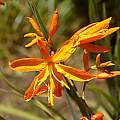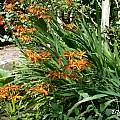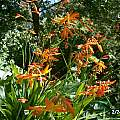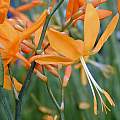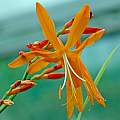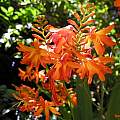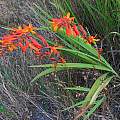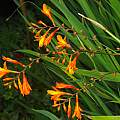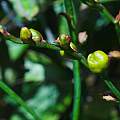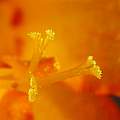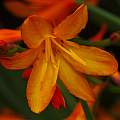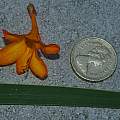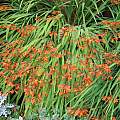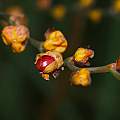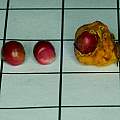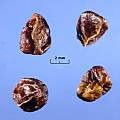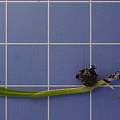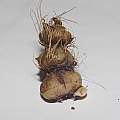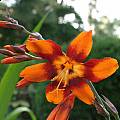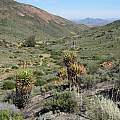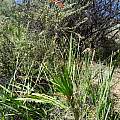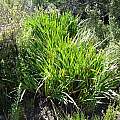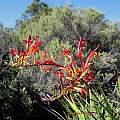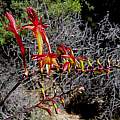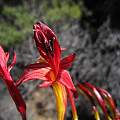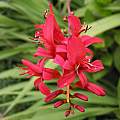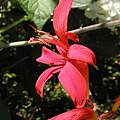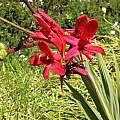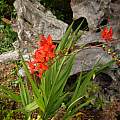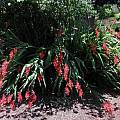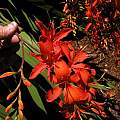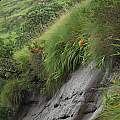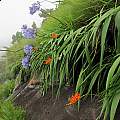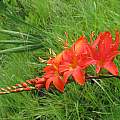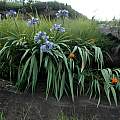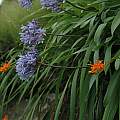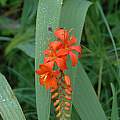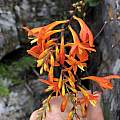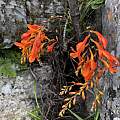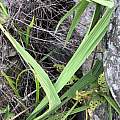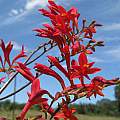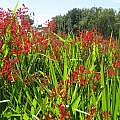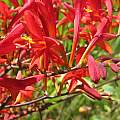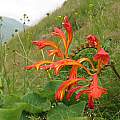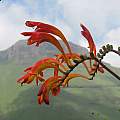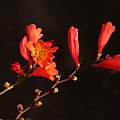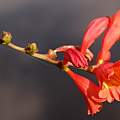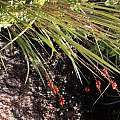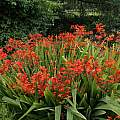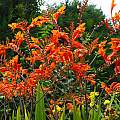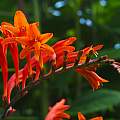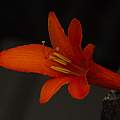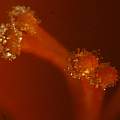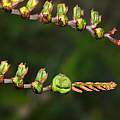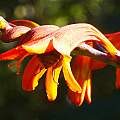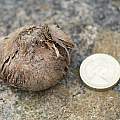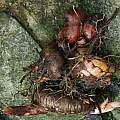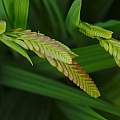Crocosmia is a genus in the Iridaceae family from tropical and eastern South Africa. Plants have erect sword shaped leaves and spikes of tubular or funnel shaped orange to red flowers. The main reference for this genus is Crocosmia and Chasmanthe by Peter Goldblatt, John Manning, and Gary Dunlop. The name comes from the Greek words krokos (saffron) and osme (odour) referring to the smell of dried leaves. Cameron McMaster has provided extremely interesting information about this genus in an article he wrote for Farmer's Weekly in 2008.
In the text below the term 'zygomorphic' refers to a flower which is only symmetric under the trivial operation of a 360° rotation, but which has a bilateral symmetry; the two halves are mirror images. The word derives from the Greek zygoun "to join or yoke". A more typical flower might have six identical petals equally spaced and be symmetric under rotations of a multiple of 60°; flowers with symmetries like this are called 'actinomorphic'; this derives from the Greek aktis "ray".
Crocosmia aurea (Pappe ex Hook.) Planch. is found in forest margins and forest floors from the Eastern Cape of South Africa to Uganda and the Central African Republic. It has sword shaped leaves and a lax arching spike of up to 10 flowers. Flowers are actinomorphic, nodding, orange, pale in the throat with tepals marked darker orange to brown and are pollinated by large swallowtail butterflies. Plants grow from 16 to 28 inches (40-70 cm) and flower late summer to mid autumn. There are two subspecies.
Crocosmia aurea ssp. aurea is a southern African subspecies. It has a multibranched flowering stem and bigger flowers. Photos taken by Cameron McMaster, Ellen Hornig and Tom Mitchell (of a plant collected in eastern Swaziland).
Crocosmia aurea ssp. pauciflora is usually unbranched (but sometimes one or two branched) and has smaller flowers.
Crocosmia × crocosmiiflora, often called Montbretia, is a frequently cultivated hybrid between Crocosmia aurea and Crocosmia pottsii. It has sword shaped leaves and orange-crimson flowers. It can be very invasive where happy as it spreads by stolons which create new corms and even when new corms are pulled out, the old corms left behind in the soil are often still viable. Height range: 1-3 ft. The first photo by Bob Rutemoeller. The second from Mary Sue Ittner shows it growing in a roadside ditch where it has naturalized on the Mendocino Sonoma coast.
Photos by David Pilling show the way that new flowers grow from the ends of the stems whilst old flowers and seeds are present further back, a seed pod, the end of the style, a flower showing the three stamens, a flower and leaf compared to a 1 inch diameter coin and a garden view.
Pictures of a ripe seed pod, fresh seeds on a 10 mm grid, dried seeds, a seedling 29 days after the seed was exposed to moisture and room temperature (70 °F, 10 mm grid) and stack of corms.
Crocosmia × crocosmiiflora 'Emily McKenzie' here photographed by and in the garden of Jim McKenney on August 7, 2005
Crocosmia fucata (Herb.) M.P.de Vos, syn. Antholyza fucata, grows from 1.3 to 2 m. It has an erect stem with three cauline leaves and 2 to 4 branches of up to 22 long tubed orange scarlet flowers adapted for pollination by sunbirds. The lower three tepals are sometimes reddish orange with a narrow red median streak with a tube that is yellow on the underside. This species is restricted to Namaqualand where it is found in locally moist habitats. Photos below were taken by Cameron McMaster November 2009 near Kamieskroon showing the habitat, leaves, and flowers.
Crocosmia 'Lucifer' (Crocosmia masoniorum × Crocosmia paniculata) is a very popular cultivar that grows to 4 feet (1.2 m) and has large rich red robust flowers. It comes true from seed and can self sow. Photos by Bob Rutemoeller.
Crocosmia masoniorum (L.Bolus) N.E.Br. is a species from the Eastern Cape of South Africa with pleated leaves and orange-red flowers. It needs regular watering while in growth from spring until summer flowering. Height range: 3-5 ft. The photos below could be of a named cultivar and were taken in the Mendocino Coast Botanical Gardens summer 2004 by Bob Rutemoeller. These plants have made a comeback after the deer fence was added and were thought lost in the past.
Photos below taken by Cameron McMaster and Bob Rutemoeller of a wild population at Satansnek Pass in the Eastern Cape. In some of these photos it is blooming at the same time as Agapanthus praecox.
Crocosmia mathewsiana (L.Bolus) Goldblatt is a narrow endemic of Mpumalanga province, South Africa, where it grows in light shade along the edges of forest or sometimes in the forest in well drained sandy ground among boulders. Plants grow from 5 to 8 ft tall (1.5 to 2.5 m) and are four to seven branched. Spikes are drooping in bud and then become horizontal and flowers are zygomorphic and bright orange. Flowering occurs from summer to early autumn. Photos from iNaturalist taken by Troos van der Merwe in Mpumalanga in February and shared under a CC BY-NC license.
Crocosmia paniculata (Klatt) Goldblatt grows to 4 to 5 ft (1.2-1.5 m) and is native to eastern southern Africa where it grows along streams, drainage lines and in marshes. Flowers are zygomorphic, deep orange to orange-brown, sometimes shaded reddish brown outside. The lower three tepals are marked in the lower third with dark red median streaks. Leaves are lanceolate and pleated and reach to the base of the spikes. Flowering occurs in summer. The photos were taken by Cameron McMaster.
Crocosmia pearsei Oberm. is native to the Drakensberg Mountains in South Africa. Plants grow in basalt outcrops and cliffs, mostly on cooler slopes at high elevations where they would have cold winters, cool summers, and well drained soil. Flowers are trumpet shaped and deep orange with a spike arching outward and mostly horizontal. This species does not respond well to cultivation. Height: to about 1 m. The photos were taken by Cameron McMaster at Sentinel Peak in KwaZulu-Natal.
Crocosmia pottsii (McNab ex Baker) N.E.Br. is a species of eastern South Africa that grows in light bush along the banks of rivers and small streams. It grows to 28-40 inches (70-100 cm) and has sword shaped leaves and spikes of up to 30 flowers in two rows. Flowers are zygomorphic, smaller than the other species, nodding, funnel shaped and orange scarlet. This species flowers early to midsummer. Photos from iNaturalist taken by Nick Helme along an edge of a stream in KwaZulu-Natal in January and shared under a CC BY-NC license.
Crocosmia unknown cultivar, photographed by David Pilling. This is a "pass along" plant, and so came with no name tag; a few pieces of root have filled the garden with vigorous clumps which grow over four feet high every summer. It is hardy, having survived temperatures as low as -15 °C with no problem. I usually chop it down to the ground in late autumn, before it dies back or the hard frosts come; in spring it sets off again. For a long time I collected the black seed like objects which form at the base of each flower and tried to grow them, with a lack of success. I concluded this was a non-fertile hybrid; actually these are seed pods without seeds. Hand pollination produces viable looking seed pods like the single one in the last photo.
Although the flowers are not pollinated they are popular with bees, the first photo of a bee in situ shows that the bees are not big enough; the second photo is of a corm along with a 1 inch diameter coin and the third shows how corms grow in a stack. Photo 4 is of flower buds.
